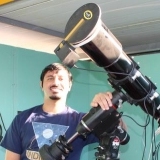Whoops, just remembered this question.
Great that you're considering to use StellarSolver for this as well. My initial thought was to just have a good bright reference star to automatically select (within the FOV, also when considering the movement vector!) and keep calculating the centroid after each new image has been downloaded. It might be a nice intermediate option. And the error vector can be updated as well of course.
In it's bare essence, the polar alignment would only have to report ALT & AZ error (even simply displaying two numbers would do) and live update those. Adjusting the PA untill both numbers are as close to zero as reasonable.
And on my second suggestion. Yes I guess something like that. The RA axis is moving back to 'home' anyway, so it could be a nice check to measure the RA axis center again with three images.
This is not particularly high-priority to me, but might be easy to implement.
Hmm are you sure about that? The coordinates you get are unrefracted, yes. But what you apply is a relative correction, based on what you see, and that is refracted positions. That's why I assumed aligning to the pole would give you the refracted one.

Can however well make a difference if you happen to live close to the equator. For me it's already 1.1 arc min, and I'm only at LAT 29
I'm not totally confident.
AIUI you are saying that because the reference star you are aligning on is refracted the pole position correction must be refracted. I'm very unconvinced about that because the refraction error of the reference star will depend on where the star is. A star that's in the South will have a refraction error that is opposite to a reference star in the North.
I think that polar aligning to a couple of arc minutes is plenty good enough for a portable set up. Getting better than that would need something like the TPoint method available with the Software Bisque mounts where a precise alignment is determined using about 100 stars, then the mount is adjusted using the high precision mount screws
×
INDI Library v2.0.7 is Released (01 Apr 2024)
Bi-monthly release with minor bug fixes and improvements
Re:New Polar Alignment Scheme and Features
Replied by ouioui01 on topic New Polar Alignment Scheme and Features
3 years 2 months ago
#66664
The topic has been locked.
- Hy Murveit
-
 Topic Author
Topic Author
- Away
- Administrator
-

- Posts: 1224
- Thank you received: 566
Replied by Hy Murveit on topic New Polar Alignment Scheme and Features
That setting isn't used in the polar alignment routine.
Hy
Hy
3 years 2 months ago
#66668
The topic has been locked.
- Jasem Mutlaq
-

- Online
- Administrator
-

Replied by Jasem Mutlaq on topic New Polar Alignment Scheme and Features
It's used implicitly whenever you perform Equatorial to Horizontal conversion, the refraction is taken into account.
3 years 2 months ago
#66671
The topic has been locked.
Replied by simont on topic New Polar Alignment Scheme and Features
uhm, it's still not clear to me if the end result of this conversions is that the alignment is done to the real or refracted pole. If any refraction effect is accounted for, I suppose that we are aligning to the real pole, since each image is put back to its unrefracted position and their center of rotation is aligned to the real pole. Instead, If no correction is applied, then the images rotate around the diffracted center of rotation, but now to which pole it is aligned?
3 years 2 months ago
#66674
The topic has been locked.
- Peter Sütterlin
-

- Offline
- Supernova Explorer
-

- Posts: 1009
- Thank you received: 133
Replied by Peter Sütterlin on topic New Polar Alignment Scheme and Features
Hmm, maybe turn the question around and ask "Which pole do you want to align to?"
If you want to align to the refracted pole, switch off the refraction correction and PA close to the pole.
If you want the real one, PA with low declination and high altitude, or use drift align.
A very quick test is to run PA at the pole, once with correction turned off, once with correction on, and compare the reported error.
If you want to align to the refracted pole, switch off the refraction correction and PA close to the pole.
If you want the real one, PA with low declination and high altitude, or use drift align.
A very quick test is to run PA at the pole, once with correction turned off, once with correction on, and compare the reported error.
3 years 2 months ago
#66677
The topic has been locked.
Replied by simont on topic New Polar Alignment Scheme and Features
I would like to align to the refracted one and see if the RA drift goes down. I will try as you suggest to repeat the PA with and without correction in Ekos settings, and see what happens.
3 years 2 months ago
#66680
The topic has been locked.
- Peter Sütterlin
-

- Offline
- Supernova Explorer
-

- Posts: 1009
- Thank you received: 133
Replied by Peter Sütterlin on topic New Polar Alignment Scheme and Features
Oh, I somehow overlooked that you look at drift in RA! PAE would show up as DEC drifts for low declination targets.
RA drift is actually something that is not dependent on PA, but in general either caused by a wrong speed of the mount, or the refraction itself when observing at lower altitudes. The latter you can only correct by proper pointing models that include the atmosphere (like 10μ does), or by using an approximation like the King rate instead of the standard sidereal rate.
RA drift is actually something that is not dependent on PA, but in general either caused by a wrong speed of the mount, or the refraction itself when observing at lower altitudes. The latter you can only correct by proper pointing models that include the atmosphere (like 10μ does), or by using an approximation like the King rate instead of the standard sidereal rate.
3 years 2 months ago
#66682
The topic has been locked.
Replied by simont on topic New Polar Alignment Scheme and Features
This is indeed why I asked to which pole the procedure align. To my understanding, King rate implementation in mounts will be beneficial only if you use it when aligned to the refracted pole.
3 years 2 months ago
#66683
The topic has been locked.
Replied by Bart on topic New Polar Alignment Scheme and Features
Whoops, just remembered this question.
Great that you're considering to use StellarSolver for this as well. My initial thought was to just have a good bright reference star to automatically select (within the FOV, also when considering the movement vector!) and keep calculating the centroid after each new image has been downloaded. It might be a nice intermediate option. And the error vector can be updated as well of course.
In it's bare essence, the polar alignment would only have to report ALT & AZ error (even simply displaying two numbers would do) and live update those. Adjusting the PA untill both numbers are as close to zero as reasonable.
And on my second suggestion. Yes I guess something like that. The RA axis is moving back to 'home' anyway, so it could be a nice check to measure the RA axis center again with three images.
This is not particularly high-priority to me, but might be easy to implement.
3 years 2 months ago
#66701
The topic has been locked.
- Chris Rowland
-

- Offline
- Platinum Member
-

- Posts: 554
- Thank you received: 138
Replied by Chris Rowland on topic New Polar Alignment Scheme and Features
It seems to me that because the three plate solved positions are reported as unrefracted JNow positions the pole position derived from them will also be unrefracted JNow.
Assuming that is the case then the best way to get to a different pole would be to correct for refraction in the JNow coordinate system. I would be less confident correcting for refraction in the observations because it will vary according to the altitude of each observation.
It's pretty good when you are getting close enough that you are worying about what pole you want to align to.
Assuming that is the case then the best way to get to a different pole would be to correct for refraction in the JNow coordinate system. I would be less confident correcting for refraction in the observations because it will vary according to the altitude of each observation.
It's pretty good when you are getting close enough that you are worying about what pole you want to align to.
3 years 2 months ago
#66727
The topic has been locked.
- Peter Sütterlin
-

- Offline
- Supernova Explorer
-

- Posts: 1009
- Thank you received: 133
Replied by Peter Sütterlin on topic New Polar Alignment Scheme and Features
Hmm are you sure about that? The coordinates you get are unrefracted, yes. But what you apply is a relative correction, based on what you see, and that is refracted positions. That's why I assumed aligning to the pole would give you the refracted one.
Can however well make a difference if you happen to live close to the equator. For me it's already 1.1 arc min, and I'm only at LAT 29
3 years 2 months ago
#66736
The topic has been locked.
- Chris Rowland
-

- Offline
- Platinum Member
-

- Posts: 554
- Thank you received: 138
Replied by Chris Rowland on topic New Polar Alignment Scheme and Features
I'm not totally confident.
AIUI you are saying that because the reference star you are aligning on is refracted the pole position correction must be refracted. I'm very unconvinced about that because the refraction error of the reference star will depend on where the star is. A star that's in the South will have a refraction error that is opposite to a reference star in the North.
I think that polar aligning to a couple of arc minutes is plenty good enough for a portable set up. Getting better than that would need something like the TPoint method available with the Software Bisque mounts where a precise alignment is determined using about 100 stars, then the mount is adjusted using the high precision mount screws
3 years 2 months ago
#66749
The topic has been locked.
Time to create page: 1.254 seconds
© 2003-2022 by INDI Library. All rights reserved.

